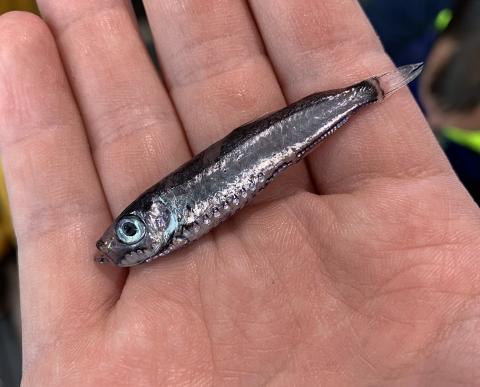
Image: Mesopeglaic fish (credit: Jethro Reading)
A recent study shed light on how mesopelagic fish help move carbon from the surface to the deep ocean. Led by the University of Southampton as part of the Natural Environment Research Council (NERC) funded BIO-Carbon programme, the research provided new data to improve models that simulate how carbon is transported in the ocean.
Findings will help scientists better understand the role of these fish in the biological carbon pump and improve predictions of how changing ocean conditions might affect fish populations and the ocean carbon cycle.
The role of vertically migrating fishes in transporting carbon is one of the least understood components of the biological carbon pump. Mesopelagic fish mostly dwell in the middle depths of the ocean in the “twilight zone”. At night they come to the surface to feed, consuming carbon, which they take to the depths as they swim down for the day.
As the most abundant vertebrates on the planet, it is estimated that mesopelagic fishes move as much carbon as zooplankton, the most abundant invertebrates. However, little is known about these small fishes. To understand how much carbon these fish can move, their activity levels - the amount of carbon each fish respires, and the influence temperature has on this - is needed.
Field metabolic rate (FMR) is the total, time-integrated metabolic rate of a wild organism. It is challenging to measure FMR in wild fishes. However, the stable isotope composition of otoliths allows retrospective estimation of both FMR and temperature.
Otoliths, also known as earstones, are hard, calcareous structures in the inner ear of bony fishes. These can provide a record of the temperature an individual fish has experienced and, dependent on the amount of otolith material sampled, the associated FMR through chemical analysis of the stable isotope composition of carbon and oxygen.
The project analysed stable isotopes in otolith edges of fish living in a range of temperatures, from the tropics to cooler regions, to allow findings to be applied across the entire Atlantic Ocean. The team described how respiration rates and in turn carbon flux vary among species and how they may alter with changing temperature and fish body size distributions.
Led by Professor Clive Trueman at the University of Southampton together with researchers from the National Oceanography Centre, Marine Institute in Ireland and the Universidad de Las Palmas de Gran Canaria, the project “Constraining respiration rates of mesopelagic fishes” ran from 2022 to 2024.
Clive says “We measured the field metabolic rates for mesopelagic fishes using the chemical composition of earstones as a natural bio-logger. We are able to show that there is a lot of diversity in activity among mesopelagic fish species and we can show which species respire the most and therefore have greater carbon export potential.”
Mesopelagic fish are not included in most carbon cycle models. This project has provided new data on how their size and the water temperature affect their role, which can now be used to improve these models. This will allow biogeochemical modellers to better assess the relative importance of fish compared to other components of the biological carbon pump. In addition, samples collected in Spring 2023 have extended a dataset which reveals how energy use varies across the whole marine fish tree of life.
These findings will aid predictions of climate change responses in a range of commercially important fishes as well as predicting the response of the biological carbon pump to changing ocean temperatures due to climate change. This will contribute to the BIO-Carbon Challenge 2 “How will the rate at which marine life converts dissolved CO2 into organic carbon change?”.
Looking forward, the project findings will be published in a synthesis paper and the important work will be further supported through collaborative efforts with the SUMMER and JETZON projects and new research partnerships.
- Log in to post comments